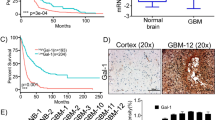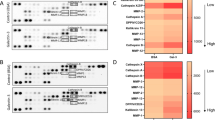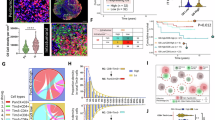Abstract
Galectin-1, a mammalian lectin expressed in many tissues, induces death of diverse cell types, including lymphocytes and tumor cells. The galectin-1 T cell death pathway is novel and distinct from other death pathways, including those initiated by Fas and corticosteroids. We have found that galectin-1 binding to human T cell lines triggered rapid translocation of endonuclease G from mitochondria to nuclei. However, endonuclease G nuclear translocation occurred without cytochrome c release from mitochondria, without nuclear translocation of apoptosis-inducing factor, and prior to loss of mitochondrial membrane potential. Galectin-1 treatment did not result in caspase activation, nor was death blocked by caspase inhibitors. However, galectin-1 cell death was inhibited by intracellular expression of galectin-3, and galectin-3 expression inhibited the eventual loss of mitochondrial membrane potential. Galectin-1-induced cell death proceeds via a caspase-independent pathway that involves a unique pattern of mitochondrial events, and different galectin family members can coordinately regulate susceptibility to cell death.
Similar content being viewed by others
Log in or create a free account to read this content
Gain free access to this article, as well as selected content from this journal and more on nature.com
or
Abbreviations
- PS:
-
phosphatidylserine
- zVAD-fmk:
-
z-Val-Ala-Asp(OMe)-CH2F
- zDEVD-fmk:
-
z-Asp-Glu-Val-Asp(OMe)-CH2F
- PARP:
-
poly(ADP-ribose)polymerase
- 7AAD:
-
7-amino-actinomycin D
- zDEVD-AFC:
-
z-Asp-Glu-Val-Asp-7-amino-4-trifluoromethylcoumarin
- Δψm:
-
mitochondrial membrane potential
- EndoG:
-
endonuclease G
- NAO:
-
10-N-nonyl acridine orange
- AIF:
-
apoptosis-inducing factor
- tBid:
-
truncated Bid
- PI:
-
propidium iodide
- FITC:
-
fluorescein isothiocyanate
References
Hunot S and Flavell RA (2001) Death of a monopoly? Science 292: 865–866
Leist M and Jaattela M (2001) Four deaths and a funeral: from caspases to alternative mechanisms. Nat. Rev. Mol. Cell Biol. 2: 589–598
Jaattela M and Tschopp J (2000) Caspase-independent cell death in T lymphocytes. Nat. Immunol. 4: 416–423
Perillo NL, Pace K, Seilhamer JJ and Baum LG (1995) Apoptosis of T cells mediated by galectin-1. Nature 378: 736–739
Perillo NL, Uittenbogaart CH, Nguyen JT and Baum LG (1997) Galectin-1, an endogenous lectin produced by thymic epithelial cells, induces apoptosis of human thymocytes. J. Exp. Med. 185: 1851–1858
Rabinovich GA, Baum LG, Tinari N, Paganelli R, Natoli C, Liu F-T and Iacobelli S (2002) Galectins and their ligands: amplifiers, silencers or tuners of the inflammatory response? Trends Immunol. 23: 313–320
Yang R-Y, Hsu DK and Liu F-T (1996) Expression of galectin-3 modulates T-cell growth and apoptosis. Proc. Natl. Acad. Sci. 93: 6737–6742
Akahani S, Nangia-Makker P, Inohara H, Kim HR and Raz A (1997) Galectin-3: a novel antiapoptotic molecule with a functional BH1 (NWGR) domain of Bcl-2 family. Cancer Res. 57: 5272–5276
Matarrese P, Fusco O, Tinari N, Natoli C, Liu F-T, Semeraro ML, Malorni W and Iacobelli S (2000) Galectin-3 overexpression protects from apoptosis by improving cell adhesion properties. Int. J. Cancer. 85: 545–554
Yu F, Finley RL, Raz A and Kim HR (2002) Galectin-3 translocates to the perinuclear membranes and inhibits cytochrome c release from the mitochondria: a role for synexin in galectin-3 translocation. J. Biol. Chem. 277: 15819–15827
Fouillit M, Joubert-Caron R, Poirier F, Bourin P, Monostori E, Levi-Strauss M, Raphael M, Bladier D and Caron M (2000) Regulation of CD45-induced signaling by galectin-1 in Burkitt lymphoma B cells. Glycobiology 10: 413–419
Wells V, Davies D and Mallucci L (1999) Cell cycle arrest and induction of apoptosis by beta galactoside binding protein (beta GBP) in human mammary cancer cells. A potential new approach to cancer control. Eur. J. Cancer 35: 978–983
Ellerhorst J, Nguyen T, Cooper DN, Estrov Y, Lotan D and Lotan R (1999) Induction of differentiation and apoptosis in the prostate cancer cell line LNCaP by sodium butyrate and galectin-1. Int. J. Oncol. 14: 225–232
Cooper DNW and Barondes SH (1999) God must love galectins; He made so many of them. Glycobiology 9: 979–984
Li LY, Luo X and Wang X (2001) Endonuclease G is an apoptotic DNase when released from mitochondria. Nature 412: 95–99
Parrish J, Li L, Klotz K, Ledwich D, Wang X and Xue D (2001) Mitochondrial endonuclease G is important for apoptosis in C. elegans. Nature 412: 90–94
Su X, Zhou T, Wang Z, Yang P, Jope RS and Mountz JD (1995) Defective expression of hematopoietic cell protein tyrosine phosphatase (HCP) in lymphoid cells blocks Fas-mediated apoptosis. Immunity 2: 353–362
Liu X, Zou H, Slaughter C and Wang X (1997) DFF, a heterodimeric protein that functions downstream of caspase-3 to trigger DNA fragmentation during apoptosis. Cell 89: 175–184
Cui H, Matsui K, Omura S, Schauer SL, Matulka RA, Sonenshein GE and Ju S-T (1997) Proteasome regulation of activation-induced T cell death. Proc. Natl. Acad. Sci. USA 94: 7515–7520
Squier MK, Sehnert AJ, Sellins KS, Malkinson AM, Takano E and Cohen JJ (1999) Calpain and calpastatin regulate neutrophil apoptosis. J. Cell. Phys. 178: 311–319
Robert A, Miron M-J, Champagne C, Gingras M-C, Branton PE and Lavoie JN (2002) Distinct cell death pathways triggered by the adenovirus early region 4 ORF 4 protein. J. Cell Biol. 158: 519–528
Wolf BB and Green DR (2002) Apoptosis: letting slip the dogs of war. Curr. Biol. 12: R177–R179
Ravagnan L, Roumier T and Kroemer G (2002) Mitochondria, the killer organelles and their weapons. J. Cell Physiol. 192: 131–137
Wang X (2001) The expanding role of mitochondria in apoptosis. Genes Dev. 15: 2922–2933
Arnoult D, Gaume B, Karbowski M, Sharpe JC, Cecconi F and Youle RJ (2003) Mitochondrial release of AIF and EndoG requires caspase activation downstream of Bax/Bak-mediated permeabilization. EMBO J. 22: 4385–4399
von Ahsen O, Renken C, Perkins G, Kluck RM, Bossy-Wetzel E and Newmeyer DD (2000) Preservation of mitochondrial structure and function after Bid- or Bax-mediated cytochrome c release. J. Cell Biol. 150: 1027–1036
Ott M, Robertson JD, Gogvadze V, Zhivotovsky B and Orrenius S (2002) Cytochrome c release from mitochondria proceeds by a two-step process. Proc. Natl. Acad. Sci. USA 99: 1259–1263
Wang G, Wieckowski W, Goldstein LA, Gastman BR, Rabinovitz A, Gambotto A, Li S, Fang B, Yin X and Rabinowich H (2001) Resistance to granzyme B-mediated cytochrome c release in Bak-deficient cells. J. Exp. Med. 194: 1325–1337
Rabinovich GA, Alonso CR, Sotomayor CE, Durand S, Bocco JL and Riera CM (2000) Molecular mechanisms implicated in galectin-1-induced apoptosis: activation of the AP-1 transcription factor and downregulation of Bcl-2. Cell Death Differ. 7: 747–753
Susin SA, Lorenzo HK, Zamzami N, Marzo I, Snow BE, Brothers GM, Mangion J, Jacotot E, Costantini P, Loeffler M, Larochette N, Goodlett DR, Aebersold R, Siderovski DP, Penninger JM and Kroemer G (1999) Molecular characterization of mitochondrial apoptosis-inducing factor. Nature 397: 441–446
Yu SW, Wang H, Poitras MF, Coombs C, Bowers WJ, Federoff HJ, Poirier GG, Dawson TM and Dawson VL (2002) Mediation of poly(ADP-ribose) polymerase-1-dependent cell death by apoptosis-inducing factor. Science 297: 259–263
Cregan SP, Fortin A, MacLaurin JG, Callaghan SM, Cecconi F, Yu SW, Dawson TM, Dawson VL, Park DS, Kroemer G and Slack RS (2002) Apoptosis-inducing factor is involved in the regulation of caspase-independent neuronal cell death. J. Cell Biol. 158: 507–517
Wang X, Yang C, Chai J, Shi Y and Due X (2002) Mechanisms of AIF-mediated apoptotic DNA degradation in Caenorhabditis elegans. Science 298: 1587–1592
Newmeyer DD and Ferguson-Miller S (2003) Mitochondria: releasing power for life and unleashing the machineries of death. Cell 112: 481–490
Colnot C, Ripoche MA, Milon G, Montagutelli X, Crocker PR and Poirier F (1998) Maintenance of granulocyte numbers during acute peritonitis is defective in galectin-3-null mice. Immunology 94: 290–296
Hsu DK, Yang R-Y, Yu L, Pan Z, Salomon DR, Fung-Leung W-P and Liu FT (2000) Targeted disruption of the galectin-3 gene results in attenuated peritoneal inflammatory responses. Am. J. Pathol. 156: 1073–1083
Moon B-K, Lee YJ, Battle P, Jessup JM, Raz A and Kim HR (2001) Galectin-3 protects human breast carcinoma cells against nitric oxide-induced apoptosis. Am. J. Pathol. 159: 1055–1060
Pace KE, Lee C, Stewart PL and Baum LG (1999) Restricted receptor segregation into membrane microdomains occurs on human T cells during apoptosis induced by galectin-1. J. Immunol. 163: 3801–3811
Belau-Rotureau M-A, Lacombe F, Durrieu F, Vial J-P, Lacoste L, Bernard P and Belloc F (1999) Ceramide-induced apoptosis occurs independently of caspases and is decreased by leupeptin. Cell Death Differ. 6: 788–795
Liu Y-Y, Han T-Y, Giuliano AF and Cabot MC (1999) Expression of glucosylceramide synthase, converting ceramide to glucosylceramide, confers adriamycin resistance in human breast cancer cells. J. Biol. Chem. 274: 1140–1146
Bratton DL, Fadok VA, Richter DA, Kailey JM, Guthrie LA and Henson PM (1997) Appearance of phosphatidylserine on apoptotic cells requires calcium-mediated nonspecific flip-flop and is enhanced by loss of the aminophospholipid translocase. J. Biol. Chem. 272: 26159–26165
Pace KE, Hahn HP, Pang M, Nguyen JT and Baum LG (2000) CD7 delivers a pro-apoptotic signal during galectin-1-induced T cell death. J. Immunol. 165: 2331–2334
van Loo G, Schotte P, van Gurp M, Demol H, Hoorelbeke B, Gevaert K, Rodriguez I, Ruiz-Carrillo A, Vandekerckhove J, Declercq W, Beyaert R and Vandenabeele P (2001) Endonuclease G: a mitochondrial protein released in apoptosis and involved in caspase-independent DNA degradation. Cell Death Differ. 8: 1136–1142
Finucane DM, Waterhouse NJ, Amarante-Mendes GP, Cotter TG and Green DR (1999) Collapse of the inner mitochondrial transmembrane potential is not required for apoptosis of HL60 cells. Exp. Cell Res. 251: 166–174
Scorrano L and Korsmeyer SJ (2003) Mechanisms of cytochrome c release by proapoptotic BCL-2 family members. Biochem. Biophys. Res. Commun. 304: 437–444
van Loo G, Saelens X, van Gurp M, MacFarlane M, Martin SJ and Vandenabeele P (2002) The role of mitochondrial factors in apoptosis: a Russian roulette with more than one bullet. Cell Death Differ. 9: 1031–1042
Zamzami N and Kroemer G (2003) Apoptosis: mitochondrial membrane permeabilization – the (w)hole story? Curr. Biol. 13: R71–R73
Ren J, Agata N, Chen D, Li Y, Yu WH, Huang L, Raina D, Chen W, Kharbanda S and Kufe D (2004) Human MUC1 carcinoma-associated protein confers resistance to genotoxic anticancer agents. Cancer Cell 5: 163–175
van Loo G, Demol H, van Gurp M, Hoorelbeke B, Schotte P, Beyaert R, Zhivotovsky B, Gevaert K, Declercq W, Vandekerckhove J and Vandenabeele P (2002) A matrix-assisted laser desorption ionization post-source decay (MALDI-PSD) analysis of proteins released from isolated liver mitochondria treated with recombinant truncated Bid. Cell Death Differ. 9: 301–308
Luo X, Budiharjo I, Zou H, Slaughter C and Wang X (2000) Bid, a Bcl2 interacting protein, mediates cytochrome c release from mitochondria in response to activation of cell surface death receptors. Cell 94: 481–490
Rabinovich GA, Ramhorst RE, Rubinstein N, Corigliano A, Daroqui MC, Kier-Joffe EB and Fainboim L (2002) Induction of allogenic T-cell hyporesponsiveness by galectin-1-mediated apoptotic and non-apoptotic mechanisms. Cell Death Differ. 9: 661–670
Kashio Y, Nakamura K, Abedin MJ, Seki M, Nishi N, Yoshida N, Nakamura T and Hirashima M (2003) Galectin-9 induces apoptosis through the calcium–calpain–caspase-1 pathway. J. Immunol. 170: 3631–3636
Dias-Baruffi M, Zhu H, Cho M, Karmakar S, McEver RP and Cummings RD (2003) Dimeric galectin-1 induces surface exposure of phosphatidylserine and phagocytic recognition of leukocytes without inducing apoptosis. J. Biol. Chem. 278: 41282–41293
Kasai K and Hirabayashi J (1996) Galectins: a family of animal lectins that decipher glycocodes. J. Biochem. (Tokyo) 119: 1–8
Olie RA, Durrieu F, Cornillon S, Loughran G, Gross J, Earnshaw WC and Golstein P (1998) Apparent caspase independence of programmed cell death in Dictyostelium. Curr. Biol. 8: 955–958
Frohlich K-U and Madeo F (2000) Apoptosis in yeast – a monocellular organism exhibits altruistic behavior. FEBS Lett. 473: 6–9
Rubinstein N, Alvarez M, Zwirner NW, Toscano MA, Ilarregui JM, Bravo A, Mordoh J, Fainboim L, Podhajcer OL and Rabinovich GA (2004) Targeted inhibition of galectin-1 gene expression in tumor cells results in heightened T cell-mediated rejection; a potential mechanism of tumor-immune privilege. Cancer Cell 5: 241–251
Vespa GNR, Lewis LA, Kozak KR, Moran M, Nguyen JT, Baum LG and Miceli MC (1999) Galectin-1 specifically modulates TCR signals to enhance TCR apoptosis but inhibit IL-2 production and proliferation. J. Immunol. 162: 799–806
Amano M, Galvan M, He J and Baum LG (2003) The ST6Gal I sialyltransferase selectively modifies CD45 and negatively regulates galectin-1 induced CD45 clustering, phosphatase modulation and T cell death. J. Biol. Chem. 278: 7469–7475
Acknowledgements
We thank Myles Cabot and Brett Premack, and the staff at the Jonsson Comprehensive Cancer Center Flow Cytometry Core. This work was supported in part by NIH training grants GM08042 (to HPH and JDH) and AI52031 (to JDH), NIH GM63281 (to LGB), NIH GM57158 and I-1412 from the Welch Foundation (to XW) and NIH AI20958 (to F-TL).
Author information
Authors and Affiliations
Corresponding author
Additional information
Edited by G Nunez
Rights and permissions
About this article
Cite this article
Hahn, H., Pang, M., He, J. et al. Galectin-1 induces nuclear translocation of endonuclease G in caspase- and cytochrome c-independent T cell death. Cell Death Differ 11, 1277–1286 (2004). https://doi.org/10.1038/sj.cdd.4401485
Received:
Accepted:
Published:
Issue date:
DOI: https://doi.org/10.1038/sj.cdd.4401485
Keywords
This article is cited by
-
Knockdown of the Shwachman-Diamond syndrome gene, SBDS, induces galectin-1 expression and impairs cell growth
International Journal of Hematology (2024)
-
Decoding the sweet regulation of apoptosis: the role of glycosylation and galectins in apoptotic signaling pathways
Cell Death & Differentiation (2019)
-
Galectin-1 is required for the regulatory function of B cells
Scientific Reports (2018)
-
Apoptosis and anergy of T cell induced by pancreatic stellate cells-derived galectin-1 in pancreatic cancer
Tumor Biology (2015)
-
Glycobiology of cell death: when glycans and lectins govern cell fate
Cell Death & Differentiation (2013)



